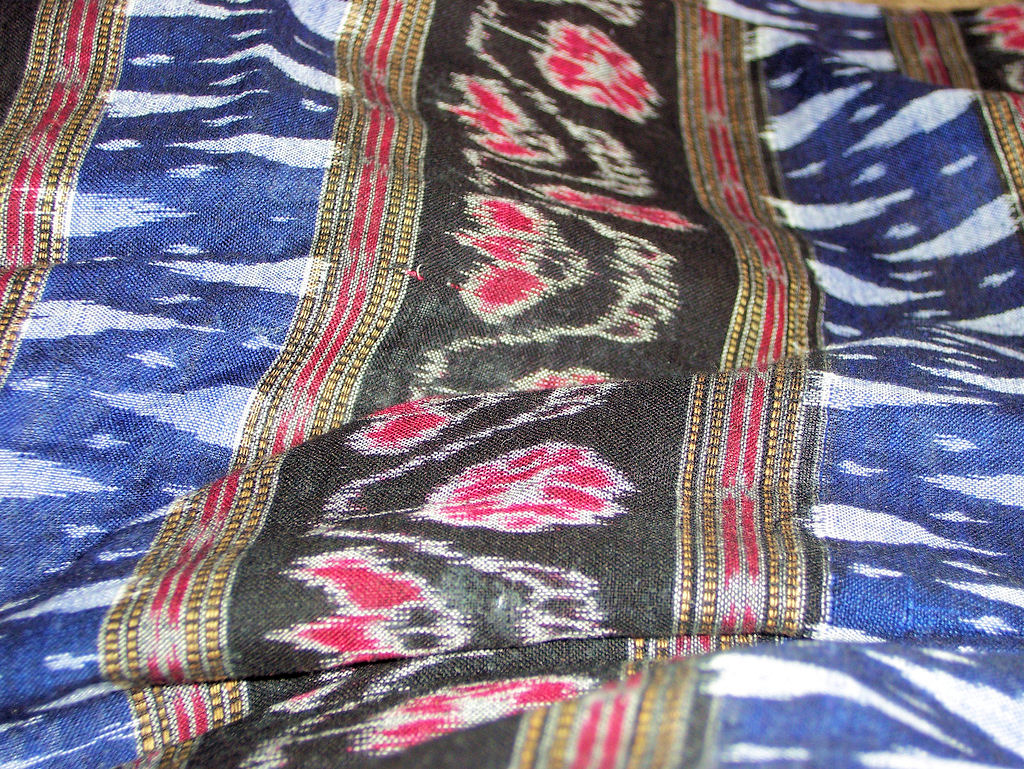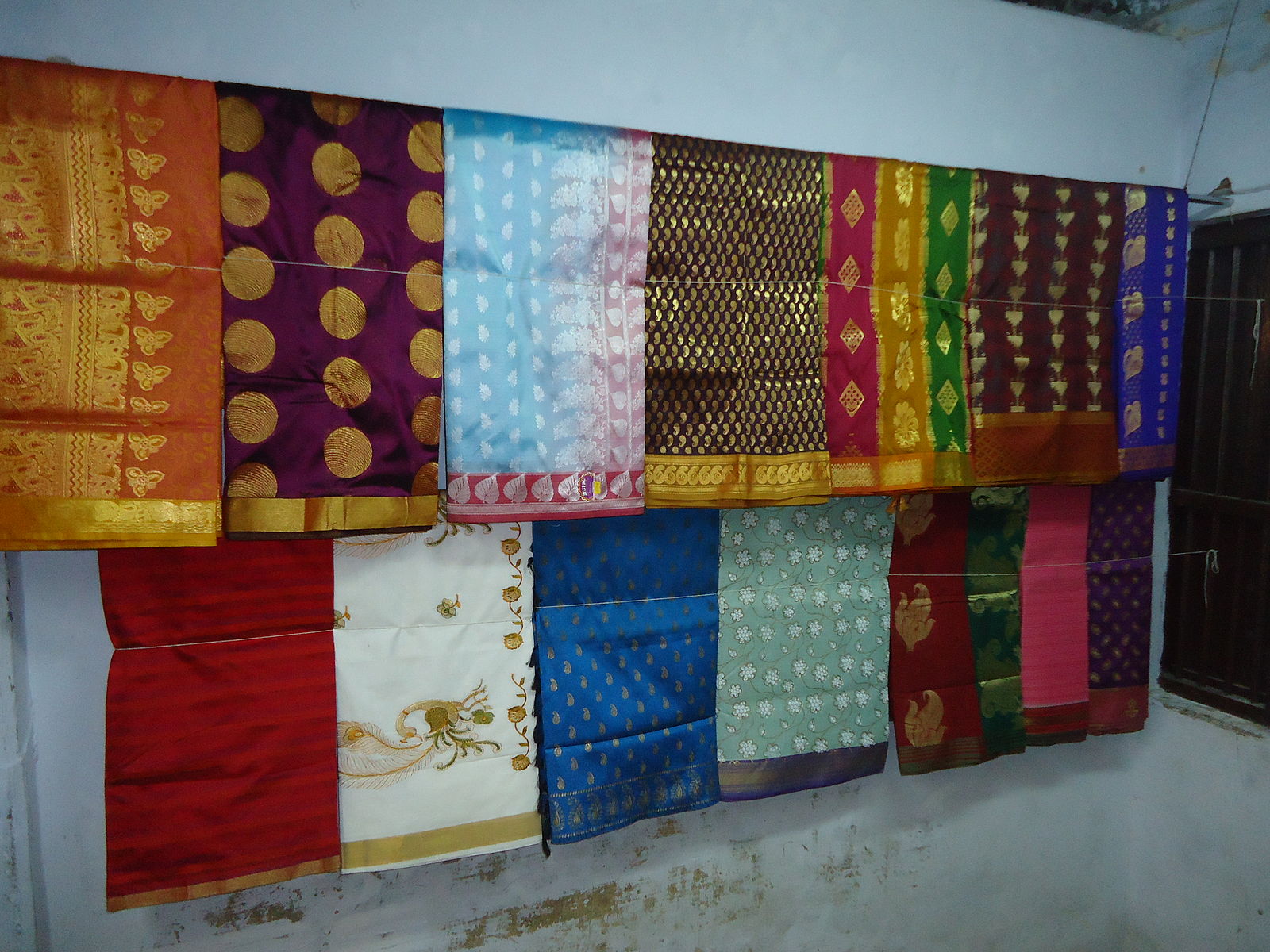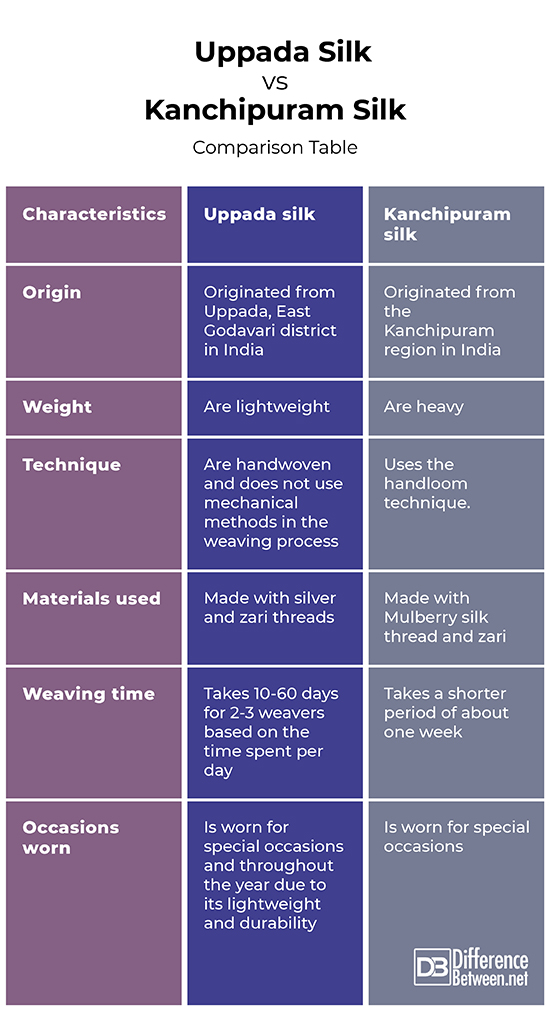Difference Between Uppada Silk and Kanchipuram Silk
The many festivities all around the year in India has seen a booming market for sarees. These are popular at weddings and other special occasions. They are durable, with some being more expensive than others. There are over 1000 saree designs, based on the weaving process, materials used and the origin, just to name a few. Examples include Uppada silk and Kanchipuram silk. Although they may look similar, they differ in various ways.
Uppada Silk
These are lightweight saris made with cotton wrap in Uppada, East Godavari district in India. They are made using non-mechanical methods and are made with pure lace which is made by dipping silver zari in melted gold, a technique first used in the year 1988. The weaving entails laying out of designs, interweaving process as well as looming, hence takes 10-60 days for 2-3 weavers based on the time spent per day. There are various designs of the Uppada silk including flowers, geometric and leaves.
Due to their lightweight and durability, they are worn throughout the year but are more common on special occasions such as gatherings and weddings.
Kanchipuram Silk
Made in the Kanchipuram region in India, this is a type of silk saree woven from pure silk and worn on special occasions such as weddings and other ceremonies. It is made from mulberry silk from the region of South India whereby three shuttles are used in the weaving process. Due to the intensity of work, two persons, the weaver and his aide, work on the saree, each on a different side. In instances where the pallu is woven in a different shade, it is woven separately then joined to the saree.
In a genuine Kanchipuram saree, the border and body are woven separately and then joined together, making the joint strong that not even a tear can detach it. Not only does its production enrich history, it also employs over 5,000 families in the region.
They have bright colors, with designs based on temples, leaves, animals, paintings and palaces. Some traditional designs in Kanchipuram sarees include checks, floral, temple borders, and checks.
Similarities between Uppada Silk and Kanchipuram Silk
- Both are popular sarees in India
- Both are vibrant and colorful
- Both are worn on special occasions such as weddings
- Both have greatly contributed to India’s textile industry
Differences between Uppada Silk and Kanchipuram Silk
Definition
Uppada Silk is a lightweight saree made with cotton wrap in Uppada, East Godavari district. On the other hand, Kanchipuram silk is a type of silk saree woven from pure silk and worn on special occasions such as weddings and other ceremonies.
Origin
Uppada silk originated from Uppada, East Godavari district in India. On the other hand, Kanchipuram silk originated from the Kanchipuram region in India.
Weight
While Uppada silk is lightweight, Kanchipuram silk is heavy.
Technique
Uppada silk is handwoven and uses non-mechanical methods. On the other hand, Kanchipuram uses the handloom technique.
Materials used
Uppada is made with silver and zari threads while Kanchipuram is made with Mulberry silk thread and zari.
Weaving time
While Uppada silk takes 10-60 days for 2-3 weavers based on the time spent per day, Kanchipuram silk takes a shorter period of about one week.
Occasions worn
While Uppada silk is worn for special occasions and throughout the year due to its lightweight and durability, Kanchipuram is worn for special occasions.
Uppada Silk vs. Kanchipuram Silk: Comparison Table
Summary of Uppada Silk vs. Kanchipuram Silk
Uppada Silk refers to lightweight sarees made with silver and zari threads in Uppada, East Godavari district. They are lightweight, and are hand-woven hence mechanical methods are not used in the weaving process. They, however, take 10-60 days for 2-3 weavers based on the time spent per day to make. On the other hand, Kanchipuram silk is a type of silk sari woven from the Mulberry silk thread and zari. It is made using the handloom technique and is worn on special occasions such as weddings and other ceremonies. Despite the differences, both are popular and stylish garments across India.
- Difference Between Profit Center and Investment Center - July 2, 2022
- Difference Between Anti-Trust and Anti-Competition - June 6, 2022
- Difference Between Stocktaking and Stock Control - June 6, 2022
Search DifferenceBetween.net :
Leave a Response
References :
[0]Racherla U & Chung K. Innovation and IPRs in China and India: Myths, Realities and Opportunities. Springer Publishers, 2016. https://books.google.co.ke/books?id=4AI1DAAAQBAJ&pg=PA49&dq=Kanchipuram+Silk&hl=en&sa=X&ved=0ahUKEwiz29SG2fbmAhWQN8AKHZ8UBfEQ6AEINjAC#v=onepage&q=Kanchipuram%20Silk&f=false
[1]Dr. Haridas B. WORLD'S ECONOMIC AND COMMERCIAL GEOGRAPHY. Lulu.com Publishers. https://books.google.co.ke/books?id=78qaDwAAQBAJ&pg=PA401&dq=Kanchipuram+Silk&hl=en&sa=X&ved=0ahUKEwiz29SG2fbmAhWQN8AKHZ8UBfEQ6AEIRjAE#v=onepage&q=Kanchipuram%20Silk&f=false
[2]Rina Kamath. Chennai. Orient Blackswan Publishers, 2000. https://books.google.co.ke/books?id=bw2vDg2fTrMC&pg=PA85&dq=Kanchipuram+Silk&hl=en&sa=X&ved=0ahUKEwiz29SG2fbmAhWQN8AKHZ8UBfEQ6AEITTAF#v=onepage&q=Kanchipuram%20Silk&f=false
[3]Image credit: https://upload.wikimedia.org/wikipedia/commons/6/6d/Sambalpuri_Saree.jpg
[4]Image credit: https://commons.wikimedia.org/wiki/File:Kanchipuram_silk_sareer.JPG



